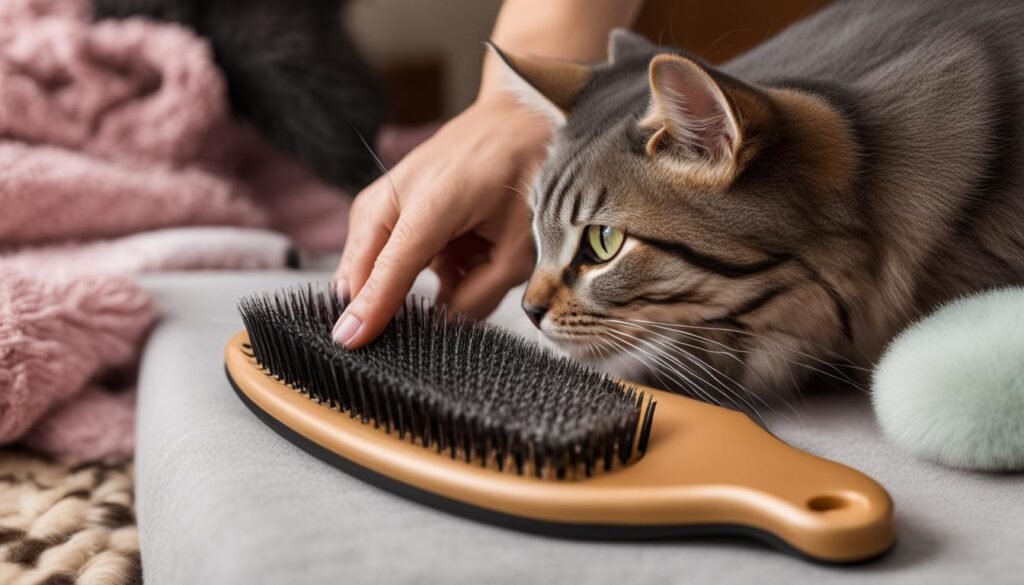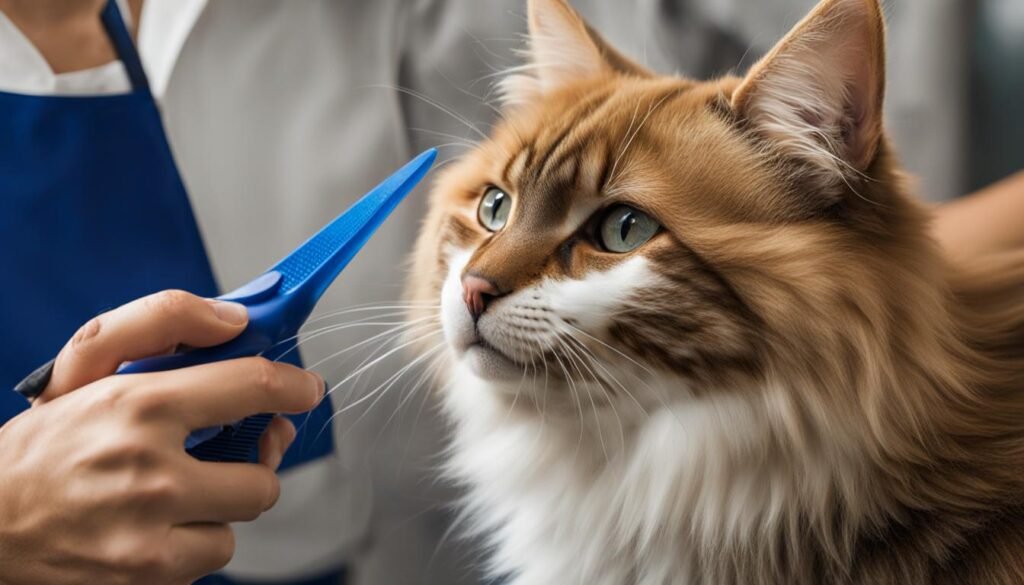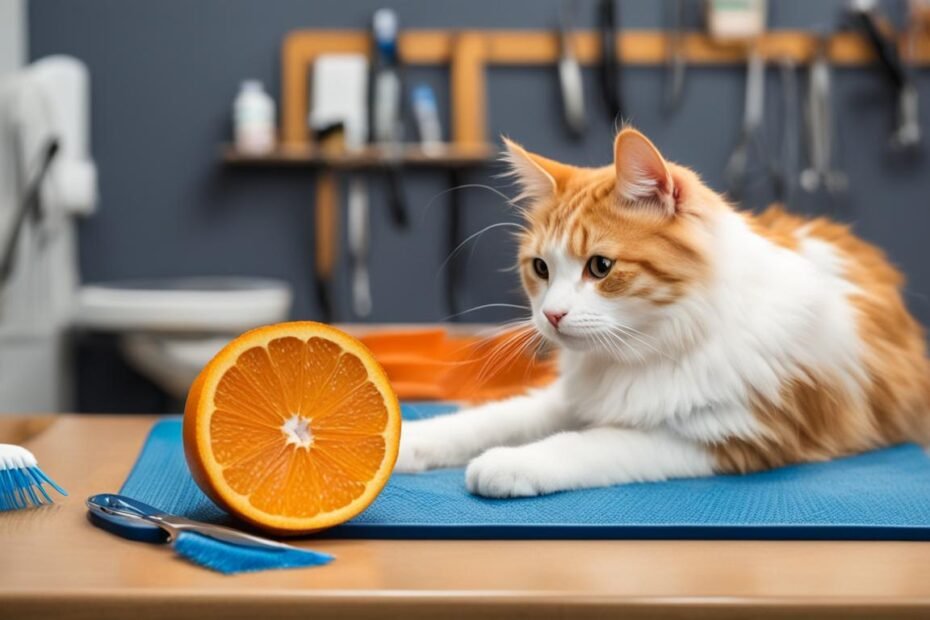Removing cat mats and tangles is essential for the health and comfort of your feline friend. Mats are comprised of clumped dead hairs, dirt, and debris, and can be painful and irritating to your cat’s skin. In this easy guide, we will provide step-by-step instructions on how to safely and effectively remove mats and tangles from your cat’s fur.
Key Takeaways:
- Cat mats and tangles can cause pain and discomfort to your cat’s skin.
- Regular grooming and brushing can prevent the formation of mats.
- Techniques such as gentle brushing and using cornstarch can help remove mats.
- Seeking professional help may be necessary in severe cases.
- A balanced diet and proper grooming play an important role in preventing cat mats.
The Importance of Removing Cat Mats
Removing cat mats is not just a matter of aesthetics – it is crucial for the overall health and well-being of your feline friend. Mats, which are clumps of tangled fur, can cause a range of health risks for your cat. These painful mats can lead to skin irritation, infections, and even bruising. They can also trap dirt, bacteria, and parasites, making the skin more susceptible to infection. Therefore, it is essential to address and remove mats promptly to prevent any discomfort or potential health issues for your furry companion.
Cat mats can occur in various areas of your cat’s body, including behind the ears, under the armpits, along the back, and around the tail. If left untreated, these mats can become tighter and more difficult to remove. They can also become a breeding ground for bacteria and parasites, leading to further complications. Regular grooming and mat removal is key to preventing these issues and ensuring your cat’s skin and coat remain healthy.
By keeping your cat’s fur free from mats, you are not only promoting their comfort, but you are also maintaining good hygiene and preventing potential medical problems. Removing mats also allows for better air circulation around the skin, reducing the risk of moisture buildup and fungal infections. It is recommended to inspect your cat’s coat regularly and address any mats or tangles immediately to ensure a happy and healthy feline companion.
Table: Common Health Risks Associated with Cat Mats
| Health Risks | Description |
|---|---|
| Skin Irritation | Mats can cause constant friction against the skin, leading to redness, inflammation, and discomfort. |
| Infections | Mats can trap moisture, dirt, and bacteria, creating an ideal environment for infections to develop. |
| Bruising | Tight mats can pull on the skin, causing bruising and potential damage to underlying tissues. |
| Parasites | Mats provide hiding places for parasites like fleas and ticks, increasing the risk of infestations. |
Techniques for Removing Cat Mats
When it comes to removing cat mats, there are several techniques that can be effective in tackling the problem. Whether you’re dealing with small mats or more severe tangles, these methods can help you safely and gently restore your cat’s fur to its natural beauty.
Gentle Brushing
Gentle brushing with a fine-toothed comb is often the first line of defense against cat mats. Start by using short, gentle strokes to untangle any loose hairs. Work your way through the mat, starting from the outer edges and gradually moving towards the center. Be patient and take care not to pull or tug on the mat, as this can cause discomfort for your feline friend.
Using Cornstarch
Another technique for removing mats involves using cornstarch. Sprinkle a small amount of cornstarch onto the mat and gently work it into the fur using your fingertips. This can help to loosen the mat and make it easier to comb out. Once the mat is loosened, use a fine-toothed comb to gently untangle the hairs.
Cutting Out Mats
In some cases, cutting out the mat may be necessary, especially if it is too tight to the skin or too large to comb out. Use blunt-end scissors to carefully cut through the mat, taking care not to cut your cat’s skin. Start by cutting the mat into smaller sections and work your way through, being cautious not to remove more hair than necessary.
Shaving Mats
For more severe mats that cannot be removed through brushing or cutting, shaving with clippers may be the best option. However, it is important to note that shaving should be done by a professional groomer or a veterinarian to ensure the safety and comfort of your cat.
By using these techniques and taking a gentle and patient approach, you can effectively remove cat mats and tangles, leaving your feline companion with a healthy and beautiful coat.

Preventing Cat Mats and Tangles
Regular grooming is key to preventing cat mats and tangles, especially for long-haired breeds. By establishing a routine of brushing and addressing tangles, you can maintain a healthy coat and avoid the discomfort caused by matting. Paying attention to specific areas prone to mats, such as the lower back and under the collar, is crucial in preventing knots from forming and becoming larger mats that are more difficult to remove.
To prevent cat mats, it’s important to brush your cat’s fur regularly. This helps remove loose hairs and prevents them from clumping together and forming mats. When brushing long-haired cats, use a brush specifically designed for their coat type, such as a wide-toothed comb or a slicker brush. These tools help to gently detangle the fur without causing any pain or discomfort for your furry friend.
In addition to regular brushing, maintaining a healthy coat plays a significant role in preventing mats. Proper nutrition is key, as it promotes healthy skin and fur. Ensure your cat’s diet includes essential nutrients like vitamin E and omega-3 fatty acids, which can improve coat health and reduce the likelihood of matting. Regular bathing, using cat-friendly grooming products, can also help keep the coat clean and free from debris that can contribute to mat formation.
The Role of Regular Grooming
Regular grooming not only helps prevent mats but also allows you to monitor your cat’s overall health. While brushing, take the time to examine your cat’s skin for any redness, irritations, or signs of parasites. Regular grooming sessions provide the opportunity to bond with your cat and create a positive experience, reinforcing trust and making future grooming sessions easier for both of you.
By implementing a regular grooming routine, focusing on brushing long-haired cats, addressing tangles, and maintaining a healthy coat, you can effectively prevent cat mats and tangles. Remember, prevention is always better than trying to remove mats once they have formed. Investing time and effort into grooming your cat will result in a happier, healthier feline companion.
| Grooming Tips: | Benefits: |
|---|---|
| Brush your cat regularly | Removes loose hairs and prevents mat formation |
| Address tangles, especially in long-haired cats | Prevents knots from becoming larger mats |
| Maintain a healthy diet with essential nutrients | Promotes a healthy coat and reduces matting |
| Regularly bathe your cat | Keeps the coat clean and free from debris |
Seeking Professional Help
If you’re dealing with severe matting or if your cat is particularly uncomfortable, it may be time to seek professional help. While many cat owners can effectively remove mats and tangles on their own, there are situations where the expertise of a professional groomer or veterinarian is needed.
A professional groomer has experience in dealing with all types of mats and can expertly address multiple mats without causing stress or discomfort to your cat. They have the right tools and techniques to safely remove mats and tangles while ensuring your cat’s well-being throughout the grooming process.
In cases where the mats are affecting your cat’s skin or if your cat requires sedation for the grooming process, a trip to the veterinarian may be necessary. Veterinarians have the expertise to diagnose any underlying skin conditions or infections caused by severe matting and provide appropriate treatment.
Remember, seeking professional help ensures that your cat receives the best care and attention, especially when dealing with severe matting or if your cat’s well-being is at stake. Don’t hesitate to reach out to a professional groomer or veterinarian to provide the necessary assistance and support for your cat’s grooming needs.

Table: When to Seek Professional Help
| Signs to look out for | When to seek professional help |
|---|---|
| Your cat is in significant discomfort or pain due to mats | Immediately |
| The mats are affecting your cat’s skin, causing redness or irritation | Immediately |
| Your cat has a history of severe matting that you are unable to manage on your own | As soon as possible |
| Your cat requires sedation or anesthesia for grooming | As recommended by your veterinarian |
“Seeking professional help ensures that your cat receives the best care and attention, especially when dealing with severe matting or if your cat’s well-being is at stake.”
Tools and Techniques for Effective Dematting
When it comes to dematting your cat’s fur, having the right tools and techniques can make all the difference in achieving successful results. Here are some essential items you’ll need:
Metal Comb:
A good quality metal comb is a versatile tool for dematting, suitable for both short-haired and long-haired cats. The fine teeth of the comb help to gently untangle knots and loosen mats, making it easier to remove them.
Detangling Spray:
A detangling spray is a useful companion when faced with stubborn mats. Spray a small amount onto the mat and allow it to sit for a few minutes. The spray helps to soften the mat, making it easier to comb out without causing discomfort to your cat.
De-matting Brush:
A de-matting brush is designed specifically for removing mats from your cat’s fur. It features sharp blades or teeth that cut through the mat, allowing you to unravel it. It’s important to use this tool with caution to avoid hurting your cat’s skin, so be gentle and take your time.
Slicker Comb:
A slicker comb is another tool that can be effective for removing mats, especially in long-haired cats. It features fine, short wires close together that can reach deep into the fur to untangle knots and remove mats. Again, use the slicker comb gently to avoid causing any discomfort to your cat.
When using these tools, it’s important to be patient and work slowly to prevent any unnecessary pulling or tugging on your cat’s fur. Regular breaks and plenty of praise or treats can help keep your cat calm and cooperative throughout the dematting process.
Tips for a Stress-Free Dematting Experience
Dematting your cat’s fur can sometimes be a challenging task, but with the right approach, you can create a stress-free experience for both you and your feline friend. Here are some tips to help you demat your cat’s fur in a relaxed and gentle manner.
1. Create a Calm Environment
Before you begin the dematting process, it’s important to create a calm and comfortable environment. Find a quiet space where you and your cat can relax without distractions. Use a soothing voice and gentle petting to help your cat feel more at ease. Remember, a relaxed cat is more likely to cooperate during the dematting session.
2. Break Down the Process
Dematting can take time, especially if your cat has multiple mats. To avoid overwhelming your cat, break down the process into smaller sessions. Focus on one or two areas at a time, allowing breaks in between. This approach will help prevent stress and discomfort for your cat and allow you to work more effectively.
3. Reward with Treats
Positive reinforcement is key to ensuring a stress-free dematting experience. Offer your cat treats throughout the process as a reward for their cooperation. This creates a positive association with dematting and helps build trust between you and your cat.
Remember, patience and gentleness are essential when dematting your cat’s fur. By following these tips, you can help make the dematting process more enjoyable for both you and your feline companion.
The Role of Diet and Grooming in Preventing Cat Mats
Diet and grooming are two crucial factors in preventing cat mats and maintaining a healthy coat. Proper nutrition and regular care can significantly reduce the risk of matting and tangles in your feline friend’s fur.
A balanced diet plays a vital role in promoting a healthy coat. Including foods rich in vitamin E and omega-3 fatty acids can enhance the overall condition of your cat’s fur and make it less prone to matting. Vitamin E helps nourish the skin and hair follicles, while omega-3 fatty acids contribute to a soft and shiny coat. Consult with your veterinarian to ensure your cat’s diet meets these essential nutritional needs.
In addition to a proper diet, regular grooming is key to preventing cat mats. Daily brushing helps remove loose hairs and prevents them from tangling and clumping together. For long-haired breeds, more frequent brushing may be necessary to prevent mats from forming. Pay special attention to areas prone to tangles, such as the armpits, behind the ears, and the tail. By keeping your cat’s fur clean and free of knots, you can minimize the risk of matting.
Grooming Tips:
- Use a brush suitable for your cat’s fur type, such as a slicker brush or a wide-toothed comb.
- Start grooming your cat from an early age to get them accustomed to the process.
- Be gentle and patient while brushing to avoid causing discomfort or pain to your cat.
- If you encounter a mat, use your fingers to gently separate the hairs before attempting to brush it out.
- Consider using a detangling spray or conditioner to make brushing easier and reduce the risk of hair breakage.
By prioritizing a healthy diet and regular grooming routine, you can help prevent cat mats and ensure your furry companion enjoys a comfortable and tangle-free coat.
Conclusion
In conclusion, maintaining healthy cat fur is essential for the overall well-being of your beloved feline friend. By following the techniques and tips outlined in this guide, you can effectively prevent and address cat mats and tangles, ensuring your cat’s comfort and happiness.
Regular grooming, including gentle brushing and addressing tangles, is key to preventing the formation of mats. Using the right tools, such as metal combs and detangling sprays, can make the dematting process easier and more successful. It’s important to create a stress-free environment by working with a relaxed cat, using a soothing voice, and offering treats.
Remember, a balanced diet rich in vitamin E and omega-3 fatty acids plays a crucial role in maintaining a healthy coat and reducing the likelihood of matting. Additionally, seeking professional help for severe matting or any discomfort your cat may experience is always a wise choice.
By implementing these practices and prioritizing your cat’s well-being, you can keep their fur smooth, tangle-free, and healthy. So start today and enjoy a wonderful bonding experience with your cat while maintaining their beautiful coat.
FAQ
Why is it important to remove cat mats?
Removing cat mats is important for the health and comfort of your feline friend. Mats can be painful and irritating to your cat’s skin and can lead to skin irritation, infections, and bruising. They can also trap dirt, bacteria, and parasites, increasing the risk of infection.
What techniques can I use to remove cat mats?
Gentle brushing with a fine-toothed comb, using cornstarch to loosen the mat, cutting out mats with blunt-end scissors, or shaving with clippers are some techniques that can be used to remove cat mats.
How can I prevent cat mats and tangles?
Regular grooming, including brushing your cat’s fur regularly, paying attention to areas prone to tangles, and maintaining a healthy coat through proper nutrition and bathing, can help prevent the formation of cat mats.
When should I seek professional help for cat mats?
If you are unable to safely remove the mats yourself, or if your cat is particularly uncomfortable or the mats are affecting the skin, it is advisable to seek professional help from a groomer or veterinarian.
What tools and techniques should I use for effective dematting?
Essential tools include a metal comb for short-haired cats, a wide-toothed comb for long-haired cats, a detangling spray, a de-matting brush for mild to moderate mats, and a slicker comb for stubborn tangles. Proper use of these tools ensures a gentle and successful dematting process.
How can I make the dematting process stress-free for my cat?
Creating a calm environment by working with a relaxed cat, using a soothing voice and gentle petting, offering treats throughout the process, and taking breaks can help make the dematting experience stress-free for your cat.
What role does diet and grooming play in preventing cat mats?
A balanced diet with sufficient vitamin E and omega-3 fatty acids promotes a healthy coat and reduces the likelihood of matting. Regular grooming, including daily brushing and regular grooming sessions, helps remove loose hairs and prevent tangles and knots from forming.
How can I maintain healthy cat fur?
By following proper techniques for removing mats, using the right tools, practicing regular grooming, and ensuring a balanced diet, you can help maintain your cat’s fur smooth, tangle-free, and healthy.
